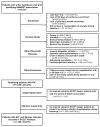Opioid Analgesics and the Risk of Serious Infections Among Patients With Rheumatoid Arthritis: A Self-Controlled Case Series Study
- PMID: 26473742
- PMCID: PMC4728045
- DOI: 10.1002/art.39462
Opioid Analgesics and the Risk of Serious Infections Among Patients With Rheumatoid Arthritis: A Self-Controlled Case Series Study
Abstract
Objective: Animal studies and in vitro human studies suggest that certain opioid analgesics impair crucial immune functions. This study was undertaken to determine whether opioid use is associated with increased risk of serious infection in patients with rheumatoid arthritis (RA).
Methods: We conducted a self-controlled case series analysis on a retrospective cohort of 13,796 patients with RA enrolled in Tennessee Medicaid in 1995-2009. Within-person comparisons of the risk of hospitalization for serious infection during periods of opioid use versus non-use were performed using conditional Poisson regression. Fixed confounders were accounted for by design; time-varying confounders included age and use of disease-modifying antirheumatic drugs, glucocorticoids, and proton-pump inhibitors. In additional analyses, risks associated with new opioid use, use of opioids known to have immunosuppressive properties, use of long-acting opioids, and different opioid dosages were assessed. Sensitivity analyses were performed to account for potential protopathic bias and confounding by indication.
Results: Among 1,790 patients with RA who had at least 1 hospitalization for serious infection, the adjusted incidence rate of serious infection was higher during periods of current opioid use compared to non-use, with an incidence rate ratio (IRR) of 1.39 (95% confidence interval [95% CI] 1.19-1.62). The incidence rate was also higher during periods of long-acting opioid use, immunosuppressive opioid use, and new opioid use compared to non-use (IRR 2.01 [95% CI 1.52-2.66], IRR 1.72 [95% CI 1.33-2.23], and IRR 2.38 [95% CI 1.65-3.42], respectively). Results of sensitivity analyses were consistent with the main findings.
Conclusion: In within-person comparisons of patients with RA, opioid use was associated with an increased risk of hospitalization for serious infection.
© 2016, American College of Rheumatology.
Conflict of interest statement
Figures


References
-
- Doran MF, Crowson CS, Pond GR, O’Fallon WM, Gabriel Se. Predictors of infection in rheumatoid arthritis. Arthritis Rheum. 2002;46:2294–300. - PubMed
-
- Michaud K, Wolfe F. Comorbidities in rheumatoid arthritis. Best Pract Res Clin Rheumatol. 2007;21:885–906. - PubMed
-
- Bongartz T, Sutton AJ, Sweeting MJ, Buchan I, Matteson EL, Montori V. Anti-TNF antibody therapy in rheumatoid arthritis and the risk of serious infections and malignancies: systematic review and meta-analysis of rare harmful effects in randomized controlled trials. JAMA. 2006;295:2275–85. - PubMed
-
- Listing J, Gerhold K, Zink A. The risk of infections associated with rheumatoid arthritis, with its comorbidity and treatment. Rheumatology (Oxford) 2013;52:53–61. - PubMed
Publication types
MeSH terms
Substances
Grants and funding
LinkOut - more resources
Full Text Sources
Other Literature Sources
Medical

